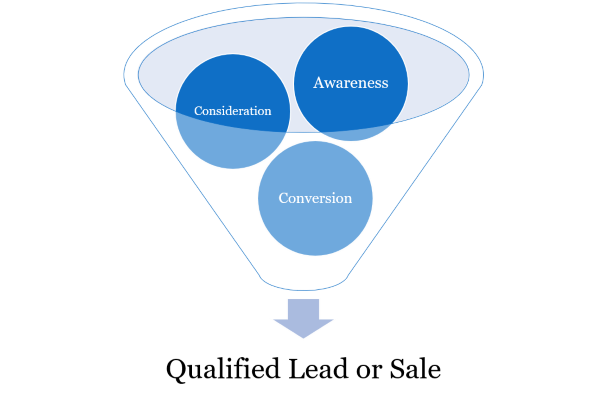Next to deciding your budget, probably the most important decision you will make during campaign set-up is the bidding strategy. Which one should you choose?
Marketing Goals Dictate Bidding Strategy
Your bidding strategy follows directly from your marketing goals. Are you aiming for awareness, consideration, or sales?
Awareness = Impressions / Views
If your marketing goal is to increase awareness, your advertising goal is to generate Impressions (Views). You could create video ads, in which case the bidding strategy is straightforward. Cost Per View (CPV) is your bidding strategy, and the only decision you have to make is the maximum bid amount.
You could also use the Search or Display Networks. With a Search Ad, your bid strategy is Target Impression Share, which tells Google what share of overall impressions you would like to get. An impression share of 10% means that your ads show up in 10% of the cases that they are eligible to show. You could look at this and target a higher impression share. With a Display Ad, your bid strategy is vCPM, or cost per thousand viewable impressions.
Consideration = Clicks
If your marketing goal is to increase consideration, OR if you are just getting started and do not have conversion data, then your advertising goal is to generate clicks. You can use Search or Display Ads, and you now have a choice to make – you can either go for Manual CPC or for the Maximize Clicks bidding strategy.
- Maximize Clicks will aim to use your entire budget and use it to drive as many clicks to your website or app as possible. This is a good option when you don’t have a cash crunch and are looking for as many leads as possible within your budget.
- Manual CPC provides you a high degree of control at the keyword level on bid amounts. With this granular control, you can adjust bids for your keywords as needed. This is a good option for anyone getting started with Google Ads, as it gives you a working understanding of paid search. It is also a good option if you have a limited budget and would like to closely monitor spend.
Sales = Conversions
If your marketing goal is to increase sales, then your advertising goal is to generate conversions. You can use Search or Display ads, and now you have a wide variety of choices for a bidding strategy. All of these strategies, except Enhanced CPC, assume that you have conversion tracking enabled on your website.
- Enhanced CPC is just that, an enhanced Manual CPC strategy. You set bids at the keyword level, but Google can override the limit as it sees fit, as long as it stays within your overall budget. Since Google considers signals such as location, device, time of day and context of search, in principle the adjustments it makes will be worth the $ spent. This strategy provides an easy transition from Manual CPC to a conversion-based strategy.
You could also pick one of the other options. These strategies will not work with a new account or campaign, as they need conversion data to work off of. Make sure you have at least 15 conversions a month before you go this route.
- Maximize Conversions – This strategy will try and use up your full budget to get you as many conversions as possible.
- Maximize Conversion Value – Announced by Google in May 2019, this strategy is similar to Maximize Conversions but it focuses on maximizing the $ value. Assuming your tagging is set up correctly, this is a better option.
- Target CPA (Cost Per Action) – If you know exactly how much you want to pay to acquire a customer, use the Target CPA strategy. Google will adjust bids so that your average cost per action is at the specified level.
- Target ROAS – ROAS stands for Return on Ad Spend. If you know how many $ in sales you want for every $ spent on ads, then specify that and Google will do the test, automatically adjusting bids to make sure you hit your target and stay within your budget.
These conversion- based strategies are automated and they take the labor-intensive task of bid management away from you, giving you time back to manage your business. Just make sure you have enough conversion data before switching to these.
Here’s a handy chart that summarizes the bid strategies we just discussed.

